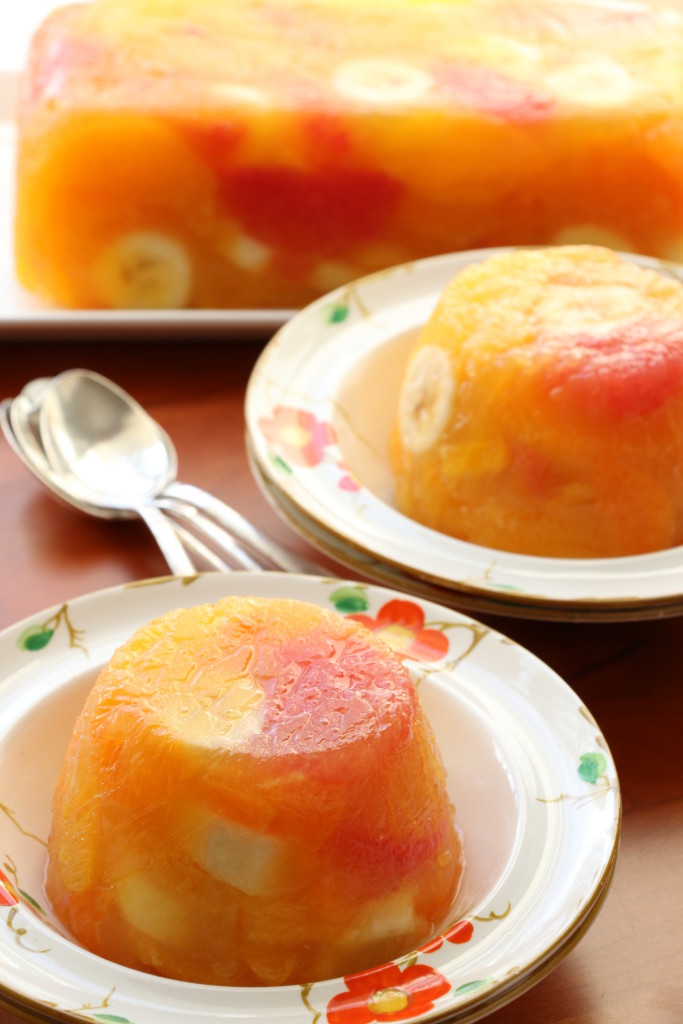 I love January. Despite its grey tendencies, I relish the fresh start, the hopeful certainty that last year’s inadequacies can be redressed by what comes next, that this year’s surprises will be of the wondrous variety.
I love January. Despite its grey tendencies, I relish the fresh start, the hopeful certainty that last year’s inadequacies can be redressed by what comes next, that this year’s surprises will be of the wondrous variety.
I’m also one of many relieved that the holidays have been navigated for another year without incident or illness, and glad of the respite from round-the-clock kitchen duty. I crave eating and preparing simple, clean-tasting foods – not self-denying or effortless foods, but those that taste of themselves with minimal interference from the cook.
Nothing does this job like the brilliant citrus at its best this month. Oranges are so ubiquitous we can forget how glorious they taste in January at the peak of their season, so juicy and sweet, nothing like their year-round impersonators. And oranges are not the only orange. The intense tangerine, distinctive in taste from its many cousins, is available for a brief couple of weeks longer, full of juice. Excellent easy-peeling satsumas and seedless clementines, also in the class of mandarin oranges along with the tangerine, are still to be had if you choose carefully from the leftover holiday supply. Look for heavy fruits with good skin.
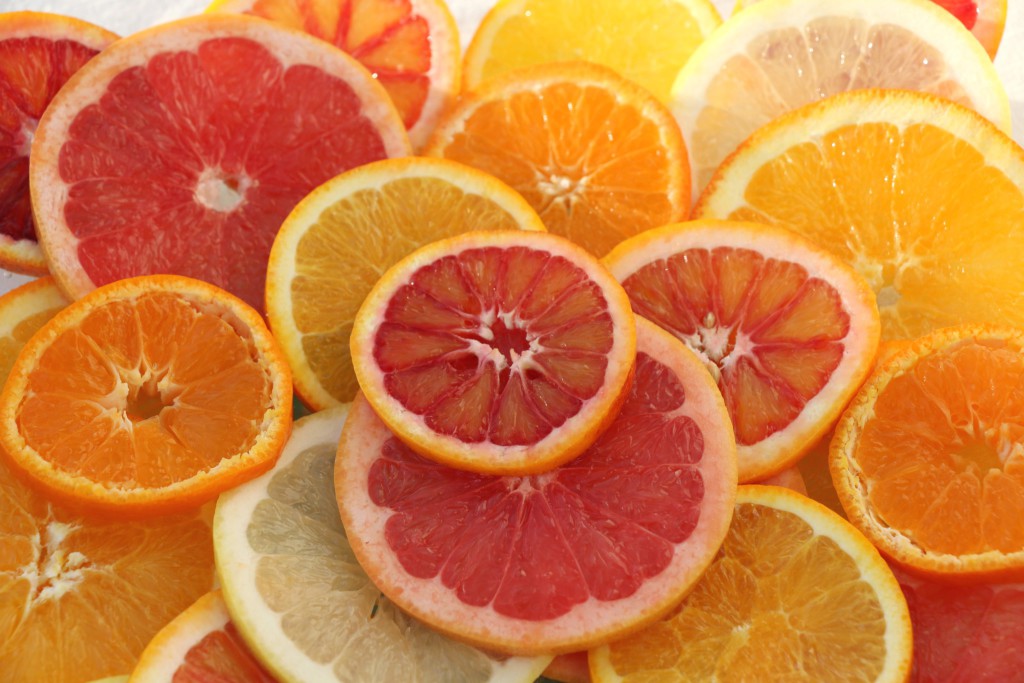 In the sweet orange class there are seedless navels and navelinas, and early Valencias with their few seeds. Grapefruit, especially the ruby red, can be as sweet as oranges now. Claret-hued blood oranges, the most celebrated of which grow in the Sicilian sun under Mt Etna, are complex, gutsy, addictive. Their cousin the blush orange is sweeter, and gorgeous with tie-dye sunset pigments, each a little different from the last.
In the sweet orange class there are seedless navels and navelinas, and early Valencias with their few seeds. Grapefruit, especially the ruby red, can be as sweet as oranges now. Claret-hued blood oranges, the most celebrated of which grow in the Sicilian sun under Mt Etna, are complex, gutsy, addictive. Their cousin the blush orange is sweeter, and gorgeous with tie-dye sunset pigments, each a little different from the last.
The best and simplest thing to do with all these treasures is to juice them and drink down all that sun and promise in a few good gulps that will make you instantly glad to be alive. As January rituals go, this is a joyously straightforward one that requires only a few good fruits and a strong hand or simple juicing device, nothing fancy. It is the ultimate convenience food and natural high, blessed with the virtues of sun and vitamins just when we need them most. Knowing you have a bowl of citrus waiting to be squeezed can make it easier to start the day and even convince you (on a weekend at least) that you’re on holiday in Italy, where spremuti from the fruits of local trees are in themselves worth the whole holiday.
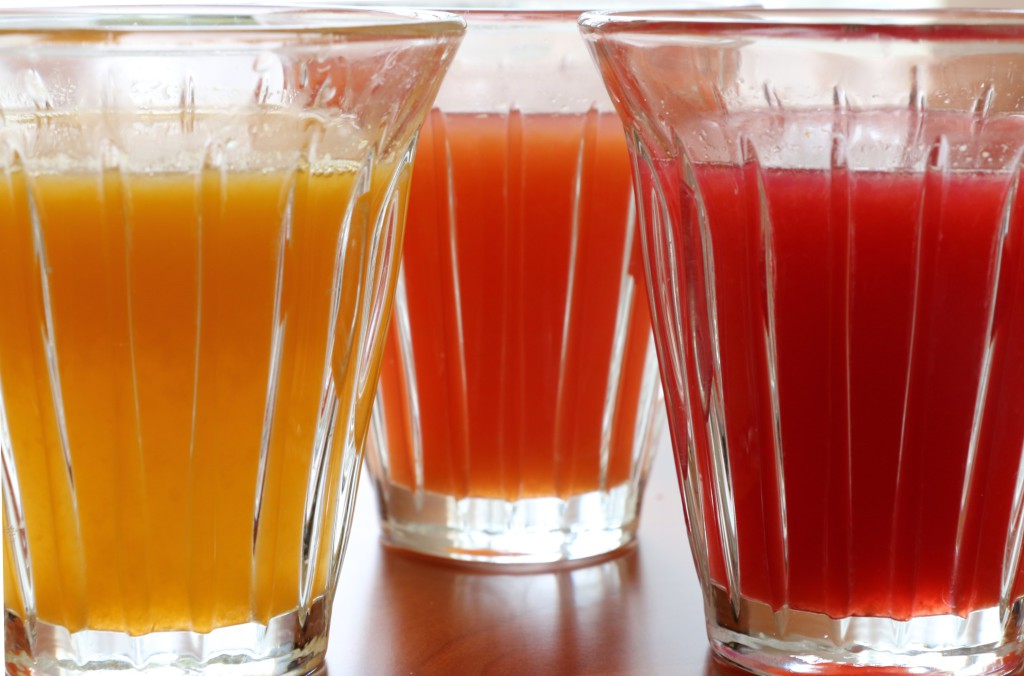 This is also the perfect time of year to experiment with cooking with citrus. Sliced in salads, squeezed onto carrots, or onto broccoli or flower sprouts (a delicious new cross between kale and Brussel sprouts), oranges add a zing to winter’s vegetables and enhance their nutritional value.
This is also the perfect time of year to experiment with cooking with citrus. Sliced in salads, squeezed onto carrots, or onto broccoli or flower sprouts (a delicious new cross between kale and Brussel sprouts), oranges add a zing to winter’s vegetables and enhance their nutritional value.
January also means the Seville oranges are in town, and there is so much more to do with these mouth-puckering, pip-filled fruits than making marmalade. The juice of the Seville is easy to squeeze and has both the notes of orange and the tartness of lemon, so makes brilliant curds, mousses, drizzle cakes, sorbets and sauces. It brightens fish, chicken, duck and guinea fowl. Frozen in small cubes it can enhance rhubarb and other fruit compotes throughout the year. Freeze a few whole and you will find many uses for them beyond the breakfast table.
‘Sour oranges’ were the oranges prized as luxuries by the Romans and medieval cooks, brought from China by Arab traders. It wasn’t until the 17th century that truly sweet oranges were cultivated in Europe, and not until the 19th century that they were for mass trade. Wartime shortages made them a precious commodity once again, and they have vacillated since between being taken for granted and being revered. What is now seemingly so commonplace a fruit is still a miracle most of us would not wish to live without.
Don’t miss the window. You owe it to yourself to get a few prime specimens this month, carry them home, wash them and put them in a bowl where you can admire them, and then one by one, hold them in your hand to marvel for a moment before you take in the scent of zest, their inner beauty, and finally, taste. Sun in winter.
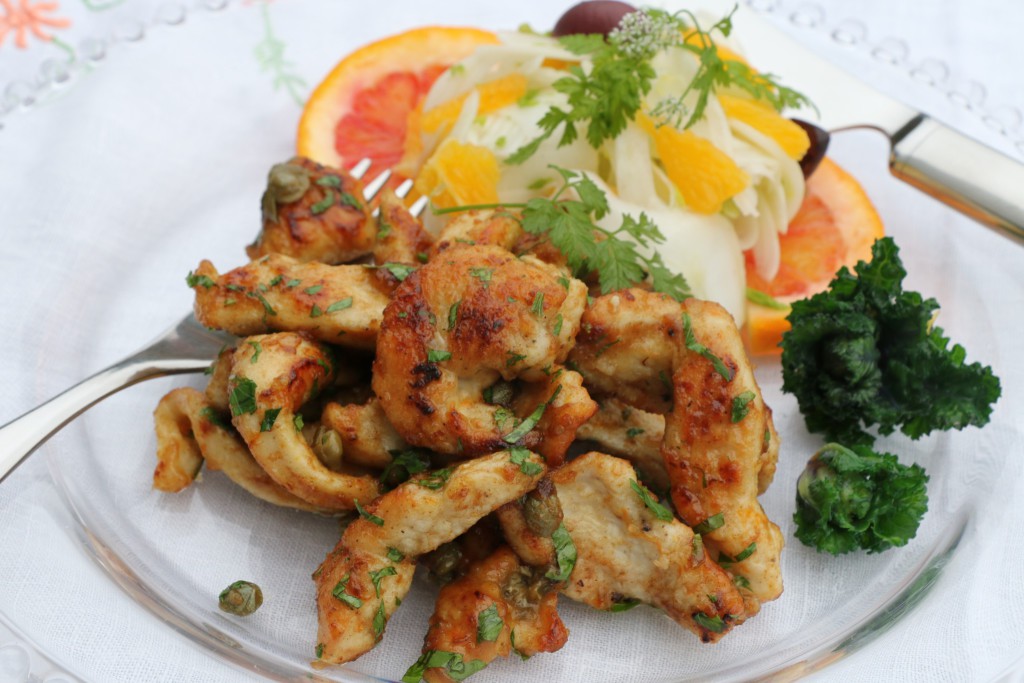 I. Hassled chicken with citrus
I. Hassled chicken with citrus
Serves 2
This dish is so quick and juicy. It’s comfort food in a flash, the zesty brightness of Seville orange or lemon on every bite-sized morsel making a week-night chicken breast anything but bland. It’s so named because you hassle your chicken pieces in the pan, cooking and turning them quickly: a little harmless kitchen therapy to redress the day’s minor harassments. It obligingly makes its own moist glaze with nothing more than the squeeze of a few citrus fruits.
A family friend gave this dish its name in the spirit of irony after a difficult day. He loved it with mashed potatoes he would dress with a legendary excess of butter. I often serve it with rice or orzo, but mash provides a double dose of comfort. A clean and crunchy salad of shaved fennel, sweet orange slices and black olive makes a sympathetic and quick accompaniment; or serve it with broccoli or flower sprouts jazzed up with garlic, olive oil and a squeeze of sweet orange juice.
Season the chicken pieces before you flour, and don’t overcook them. The pan should be hot enough for the meat quickly to take on a golden colour, but not to scorch. Stop when a skewer or knife goes through the chicken easily. This takes only about three minutes. Cooking just to doneness ensures succulence.
If scaling up the recipe, cook the chicken in batches (too much in the pan and it will steam). Keep the first batch/es lightly covered with foil on a plate in a very low oven and return them to the hot pan for a final stir with the garlic, capers, parsley and juice. This dish is best cooked just before serving so the chicken doesn’t get dry.
Ingredients:
- 2 boneless, skinless chicken breasts
- Strained juice of 4 Seville oranges or 2 lemons, about 100ml
- Finely grated zest of 1 Seville orange or lemon
- 2 minced garlic cloves
- About 60g flour (6 tablespoons) or substitute cornflour if avoiding gluten
- 1 level teaspoon sea salt and about 30 grinds of finely ground pepper
- About 50ml (3 tablespoons) olive oil
- 2 tablespoons fresh parsley leaves, chopped
- 1-2 tablespoons capers (ideally the small ‘nonpareille’)
Directions:
- Slice and season the chicken: a) Slice the breasts on the diagonal into strips about 6mm (¼ inch) thick, and halve the longest so you have uniform bite-sized pieces. b) Season with the salt and pepper, zest, and half the minced garlic (reserve the rest for the pan). Rub in well and let the pieces absorb the seasonings and come to room temperature while you get on with the rest of the meal prep.
- Flour the chicken and heat the pan: a) Put a large frying pan on to heat over medium while you flour the seasoned chicken pieces. b) Shake the chicken in a bag with the flour to coat completely.
- Cook the chicken: a) Add the oil to the pan when it has warmed up and put the heat up to medium high (one or two settings up from medium). Allow the oil to get hot but not to shimmer or smoke. b) Give the chicken pieces a good shake to get rid of excess flour (which would otherwise burn) and add them to the hot pan one by one in a single layer, taking care not to crowd the pan. The pieces should sizzle decisively but not fiercely. c) Turn with tongs or a spatula until golden on both sides, cooking only until the chicken can easily be pierced without resistance by a skewer or knife. This will take just about 3-4 minutes.
- Finish the dish: a) When the chicken is almost finished, add the remaining garlic and give it about 30 seconds to soften; don’t let it brown. b) Add the parsley and capers and give everything a quick stir. c) Quickly finish by adding the orange or lemon juice. The juice will sizzle and immediately thicken to coat the chicken pieces in a flavoursome glaze. Stir through and serve immediately.
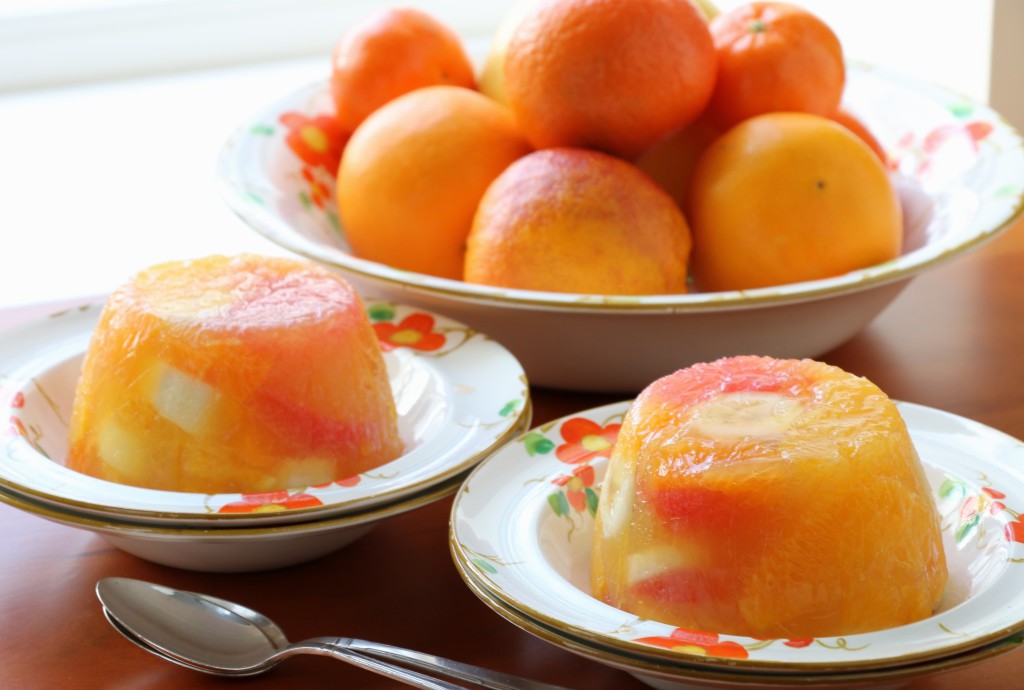 II. Fresh orange jelly with passion fruit and banana
II. Fresh orange jelly with passion fruit and banana
Serves 6-8
This vibrant pudding is packed with fruit, held together with a delicious passion fruit and orange jelly: a combination that brings out the best in both. The soft banana and tart grapefruit and blood orange make every bite interesting in taste and texture, and the colours are beautiful.
This is special enough for important celebrations and so popular you’ll want to make it often when citrus fruits are at their best. It also makes a tempting tonic for those suffering from seasonal sore throats and colds. The vitamin hit of the citrus and the protein in the gelatine makes it a wholesome pudding, soothing and delightful.
The quantity of gelatine given here allows for moulding, either as one large jelly, or in individual portions. If making a single large jelly, use a loaf tin or dish with a capacity of just over one litre, and portion the finished dessert with a serrated knife. You could instead forego the moulding and simply set the jelly in individual glasses, in which case cut down on the gelatine for a more delicate set.
This recipe calls for you to segment (i.e. to ‘supreme’) the citrus fruits so they are free of peel and pith, a silky smooth treat. The job will go faster if you use large fruits. A sharp paring knife is essential and you’ll need to work on a board or over a bowl to catch all the juices, much of which you need for the jelly (the rest is the cook’s reward for doing thirsty work).
Ingredients:
- 6 passion fruits
- 6 large sweet oranges
- 2 ruby red grapefruits, or 1 grapefruit and 3 blood oranges
- 3 small ripe bananas
- 75g caster sugar
- 1 x 12g sachet gelatine powder; use 8 grams (1 tablespoon) if not moulding the jelly
- 60ml hot water
Directions:
- Prepare the moulds: Lightly moisten the inside of one 1.25 litre jelly mould or loaf tin, or 6-8 individual moulds, and line with cling film, leaving an overhang on all sides.
- Prepare a plate for the citrus slices: Line a plate with kitchen towels to absorb excess juice from the citrus. You will need extra for each layer of fruit.
- Dissolve the gelatine: Sprinkle the gelatine over the hot water (never vice versa) and stir; set aside to soften, stirring occasionally.
- Sieve the passion fruit for the jelly: a) Place a mesh strainer over a large measuring jug (or use a bowl). Halve the passion fruits and press the pulp through the strainer to obtain as much seedless juice as you can, about 80ml. Set aside and keep the slippery seeds in the strainer for now.
- Segment (‘supreme’) the oranges: a) Cut off the tops and bottoms of each orange so it can sit flat, taking away just enough to expose the clean flesh. b) With the fruit sitting stable on a cutting board, and working from top to bottom, use a sharp paring knife to slice away the peel and white pith in downwards slices. Go just deep enough into the orange to expose the clean flesh with the minimum wastage. Follow the curve of the fruit as you get to the bottom. Continue the downwards slicing action until you’ve made it all around the fruit. c) Trim off any remaining pith you may have missed. d) Carefully cut between the membranes separating the orange segments and remove each segment cleanly. e) Lay each slice onto the prepared plate to drain.
- Make up the juice to 300ml: As you supreme the oranges, squeeze out the juice from the peels and membranes into the strainer with the passion fruit seeds; collect all the juices from the cutting board and add them too. You need enough orange juice to bring the total quantity of juice in the jug to 300ml. The orange juice will also help rinse off more passion fruit flavour from the remaining seeds in the strainer. Discard the seeds once they’ve given all their pulp.
- Finish the jelly: a) When you have collected 300ml combined passion fruit and orange juice, stir in the caster sugar. b) Heat the juice just to boiling point (on the stove or in the microwave, and don’t let it boil over). c) Remove the hot juice from the heat and stir in the softened gelatine until it is completely dissolved in the juice; set aside to cool and stir occasionally. Don’t boil the juice again once the gelatine is added; boiled gelatine tastes awful.
- Segment the grapefruit and/or blood oranges: Proceed as described for the oranges.
- Mix the fruit into the jelly: a) Once the juice with the gelatine has cooled to room temperature (it will still be liquid), strain it through a clean sieve into a bowl large enough to take all the fruit. b) Slice the bananas about 6mm (¼ inch) thick and add to the cooled juice. c) Add the drained citrus fruits and mix gently.
- Fill the moulds and chill: a) Keeping the overhanging cling film clear, fill the mould/s with fruit first, distributing it in pleasing colours with as much or little fuss as you please. b) Top up with the juice, coaxing it into all the nooks and crannies until it just covers the fruit. c) Cover the top of the mould/s with the overhanging cling film and refrigerate until the jelly is firm, about 5 hours or overnight.
- Unmould and serve: a) Open up the cling film to clear the tops of the jellies. b) Use the overhang to remove them from their moulds, and turn into serving bowls or plates, removing the rest of the cling film once they’re in place. c) If you made one large jelly, it’s easier to place a lightly moistened platter on top of the mould once the top is clear of cling film, and to then flip it right-side up before removing the mould and rest of the film. Serve cold. Leftovers last a couple of days in the fridge.
References and links
Helena Attlee. The Land Where Lemons Grow. Penguin, 2014.
Laura Donohue. Recipe for Seville orange marmalade: https://www.crumbsonthetable.co.uk/joys-seville-orange-marmalade/
Jane Grigson’s Fruit Book. Penguin 1982.
[This article was one of a series of Crumbs on the Table monthly food columns published in Weekend (editor, Alice Ryan), the Saturday supplement of the Cambridge News.]
Other orange recipes and stories on Crumbs on the Table:
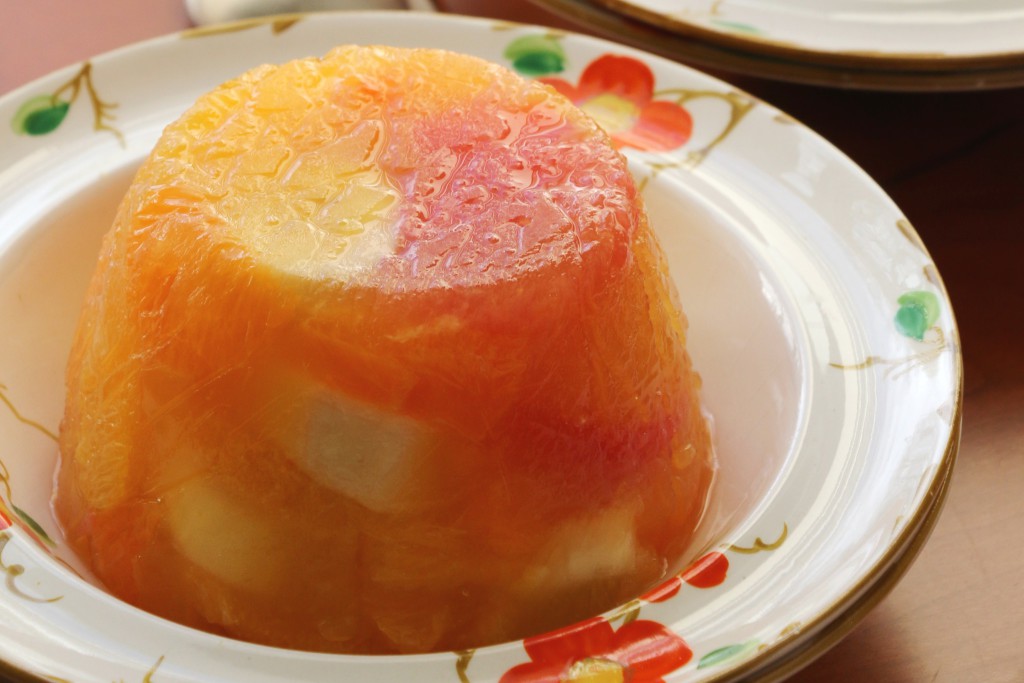
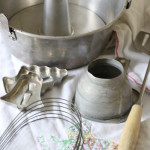
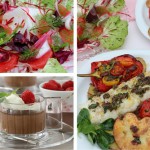
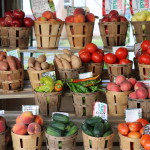
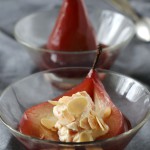
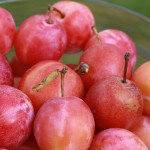
 Tour D’Argent: a remembrance of things past at today’s prices
Tour D’Argent: a remembrance of things past at today’s prices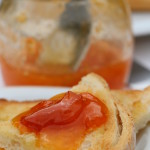 Apricots, les abricots
Apricots, les abricots I used to cook in a piggery
I used to cook in a piggery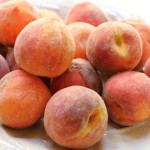

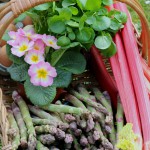


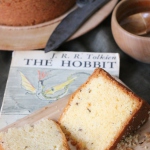 Seed cake and story
Seed cake and story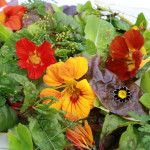
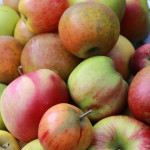
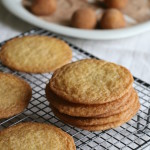
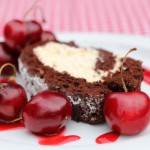
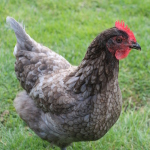
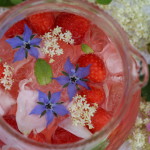
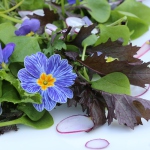

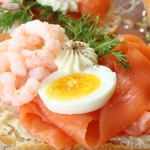
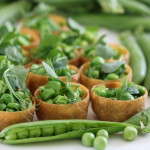

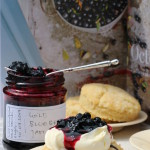
 Easter is late this year
Easter is late this year
Leave a Reply